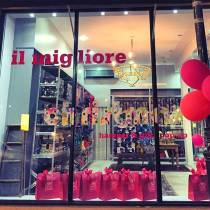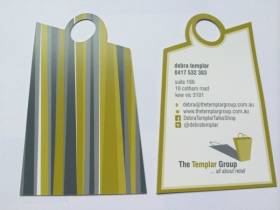ShopTorque
Thoughts, ideas, tips and musings as I work alongside small business owners helping them love their businesses back to life!
Debra
Shopping should be a pleasure for everyone involved - customers, staff and business owners - never a chore. I spend my time working with retail business owners - helping them love their businesses back to life! This blog is my thoughts, ideas, tips and musings on what I find...

When I ask prospective coffee shop owners why they want to open a cafe, they often tell me, “I thought it would be fun, I've always liked coffee.” And my response usually is, “It certainly is fun spending your life savings and then spending 80 to 90 hours each week trying to earn enough to make payroll.”
If you’re considering opening a coffee shop or cafe, consider the following questions:
Do you have a great business plan?
Do you have about $150,000 for the initial build out?
Do you have an additional $50,000 in the bank for payroll and other unexpected expenses?

In previous blog posts I talked about the importance of stamping your mark on Christmas and your window backgrounds. Let's now complete your display by looking at your Mid and Fore Grounds.
Mid Ground
This is the main body of the window display and generally provides the main opportunity to promote your products/message.
The mid ground consists of your window kit (basis to build your displays on) and the products you want to dress/promote.
A key component in the mid ground is to ensure you group the basic kit correctly first. It is vital that the whole window has a theme so that the display has maximum impact. This theme could be colour, lifestyle, brand, material/pattern, story.

Lets talk Backgrounds on your Christmas window displays. This could be the back wall of your window or a back drop that you install.
The purpose of the background is to focus your eye on the display rather than the busy environment of the shop behind.
If you have a back wall this can be painted into seasonal colour to provide interest or you can attach graphics|decals to create the right mood.
Alternatively you can create an effective background to your display by hanging a decorative garland or suspending decorative items from the ceiling.
...
Festive Cheer
If you can’t get a little creative at Christmas, when can you? While your store window displays shouldn’t all be about Christmas trees and faux snow (so unrealistic here in Oz), you shouldn’t forego the festive cheer.
Customers will expect – and love – to see your take on Christmas window dressing, so you shouldn’t be afraid to think outside the box.For retailers across all sectors, there are a lot of ways you can spread a little Christmas cheer with your windows.
...
The Christmas retailing period can represent up to 40% of a retailers annual sales. Christmas 2016 generated $48.1billion in sales. And, yes, these are Australian figures.
In order to stand out in crowded shopping centres and shopping strips this festive season, retailers are going to have to think outside the (beautifully wrapped) box. So kiss goodbye to Rudolf and tinsel. Here is my first Visual Merchandising tip for the season. (By no means am I suggesting to put up your first full Christmas window, but I am suggesting you give thought as to what you're going to do and give consideration to my suggestion below...)
Dress for the “Christmas Customer”
Before you start, it’s important to remember that your “Christmas Customer” is different from a regular shopper in shop.
While we might all be filled with a little more festive cheer at this time of year, our stress levels are up, we’re busier than ever, and we’re rushing around at 120 kilometres per hour. But perhaps the biggest difference to note is the customer journey. Your
“Christmas Customer” is a gift-giver, not an end user.
This means they need to be told something different by your window displays. Check out this Christmas Windows display board on Pinterest for ideas on how to be different and consider using mannequins in your window. Mannequins are silent, yet persuasive, sales staff.
Festive visual merchandising needs to interrupt the customer journey and display the perfect gift for a loved one (or not so loved one). By remembering this subtle shift in shopping behaviour, you can instantly create windows that drive foot traffic.

Profit and healthy cashflow come from having the stock that customers want, where they want it (ie platform or location) and when they want it. The consequences of allowing stock to get out of balaqnce with demand can be likened to a seesaw. You will go broke if you have either of these problems: too much stock or not enough stock.
Inadequate or Lack of Wanted Stock does the following:
- Creates out of stocks
- Frustrates customers
- Loses store credibility
- Loses sales and affects your cashflow
- Is the pathway to bankruptcy
Unwanted or Excessive Stock:
...Rocket Science and Cafes Featured

I recently visited a small café in a country town – that feeds from a business across the road, a business that does "it" very well. I have nothing but praise for the business across the road.
This is what I found when I visited the café:
- Umbrellas in the courtyard. Folded and closed. It was a warm day – they should have been up for the comfort of their patrons.
- Layout was strange. No signage directing you to Order Here or take a seat.
- Tables not being cleaned, as staff walked past.
- No music despite an ipod being set up and sitting there. Apparently no one could press play.
- Staff didn’t reset tables – including chairs – once customers left. This left one table with no chairs, and another two tables joined together with excess chairs.
- An owner who obviously had no hospitality experience, wandering around like a lost soul. Occasionally behind the counter, walking blindly through the café, spending lengthy time in the kitchen (hiding, I’m betting).
- Café smelled of stale oil. Insufficient strength fan in kitchen.
- Staff trying to do everything rather than having one stationed as barista, one as order taker, one as waitress. And then there was the owner, of course…
- The menu was bread heavy and full of deep fried fare.
I took a deep breath, ordered a bottle of sparkling water and watched the continual stream of customers coming in trying to decipher the rules of the place as my two friends waited and waited for their orders. Rocket Science. *sigh*
...
According to Retail Biz online magazine, data from the world’s largest job site, Indeed, reveals that Australian job seekers started looking for casual Christmas work in August, a month earlier than the historical pattern of searching in late September and peaking in November. This is significantly ahead of company recruiting schedules this year, with many companies not having listed their Christmas casual roles yet.
Over the Australian summer period, the economy benefits from a 170 per cent increase in casual roles, with the biggest booms coming from retail, representing 87 per cent of the Christmas casual roles listed on Indeed. The retail brands attracting the most interest from job seekers this year are Cotton On, Dusk, Smiggle, Myer and DFO.
Currently Christmas casual job searches outweigh open roles by nearly 140 to 1, meaning that employers can have their pick of the bunch this year. There are more job seekers this year, with searches increasing 257% over last year. Currently there are 5% more casual Christmas roles on the market than 2014, although this is likely to increase further in the run up to Christmas.
...
Before you start, it’s important to remember that your “Christmas Customer” is different from a regular shopper in store.
While we might all be filled with a little more festive cheer at this time of year, our stress levels are up, we’re busier than ever, and we’re rushing around at 120 kilometres per hour. But perhaps the biggest difference to note is the customer journey. Your “Christmas Customer” is a gift-giver, not an end user.
This means they need to be told something different by your window displays. Check out this Christmas Windows display board on Pinterest for ideas on how to be different and consider using mannequins in your window. Mannequins are silent, yet persuasive, sales staff.
...
Instagram boasts 15 times more engagement than Facebook and more than Twitter or Google. In between the latest selfies (which may or may not include your pets, your cool new bedding or your just-ordered meal), branded hashtags and location-based tagging, it’s clear that Instagram is the channel to tap for retailers that want to make an impression.
Many young women, particularly the millennial generation born 1982 – 2000 have become their own online celebrity, documenting every aspect of their lives – and watching others do the same. Sheena Auvaire, global marketing and communications director of Topshop says “What we are seeing now with that younger millennial, is that she is peacocking on social media”. Other analysts believe that the rise of the selfie is driving young women to buy something more often.
One millennial follows Victoria Beckam and reality television stars on Instagram for fashion inspiration. But she also follows retailers such as Zara and Topshop. “I like to emulate the luxury fashion brands. Seeing what new styles have come into the shops, via Instagram, helps me decided what I may want to buy”.
...
Most of the horses in horse racing don't win the big stakes by much more than a nose.
Sprinters win by fractions of seconds. The same with swimmers. Cyclists win by a hair's breadth. Many football games are won by only one goal - just a flick or a kick or a nudge of the ball a couple of degrees either way will make the difference between the championship and losing.
You see, you don't have to be brilliant. Just give life a good shot and it will make a huge difference because so many others don't give a damn. You will stand out in a crowd because for most people being average is an effort but being a bit above average is not an impossible task.
...
Who started this idea that the customer is always right?
I meet retailers who are so frustrated by that statement.
- There you stand with a customer swearing that the jumper they bought last week was one size but by the tie they got it home and put it on their child the garment had changed size. You want to tell the customer that it couldn't possibly have happened but you know from the slogan that the customer is always right. You just can't bring yourself to say how sorry you are for stocking such rubbish.
- How about the situation where you warned the customer not to freeze the garlic bread because it was best eaten fresh but they did it anyway and now they are telling you that you make lousy garlic bread. You want to tell them they are stupid but then you remember that the customer is always right. The words stick in your throat and you just can't apologise for being a lousy baker.
- And then there's the day that a customer pops in unannounced and wants their hair done right away declaring that she has an appointment this time every month. You know she is wrong and yet you know you are supposed to say she is right. You split in half, dumbfounded at the idea.
And what about a thousand other instances where the customer is just plain outright, clear as day WRONG? How can you go along with 'the customer is always right'?
...
The truth is, getting organised is so challenging that many people never get organised. Why?
1. Its difficult to know where to start.
2. Its incredibly hard to find the time.
3. Its almost impossible to keep up the motivation.
There are lots of myths going around when it comes to getting and staying organised. Here are the top 7, along with the truths.
BEING ORGANISED MEANS BEING NEAT.
While you can certainly be neat AND be organised, the two terms should never be confused with each other. While you might have NEAT piles, or NEAT boxes piled one on top of the other, or objects lined up NEATLY in a straight line, you may still not be able to find a single thing when you need it. Being organised means you're using a structured system that allows you to find everything you need when you need it, and you get everything done when it's due--without frustration, chaos or stress.
Being organised is not about being neat. You can be messy and organised, and you can be neat and disorganised. If a person can find what they need, feel like they aren’t distracted from achieving their goals, and is happy in their space, then they are well organised.
There are people whose homes and offices appear neat as a pin on the surface. Yet, inside their desks and kitchen cabinets, there is no real system, and things are terribly out of control. In contrast, there are many people who live or work in a physical mess, yet feel very comfortable in this environment and can always put their hands on whatever they need in a second. I consider these people organised people.
TO BE ORGANISED IS TO BE CLEAN.
Once again, while you can be BOTH organised AND clean, those terms should not be confused. Cleaning means that you're removing dirt, grime and otherwise preparing a sanitary surface. But, you can have the cleanest home or office on the block, and still be disorganised.
Packaging Makes a Difference Featured

Every year the majority of new products fail. Some say the figure is as high as 95%. The reason is simple: Most customers don't have the time or energy to weigh the advantages and disadvantages of the products in their shopping carts, so they use a shortcut to make their decision. That shortcut is your product’s appearance and packaging.
Packaging design has become huge in the past few years as businesses are realising that great packaging equals increased sales. Think about it: When you’re choosing a bottle of wine, aren’t you drawn to the bottles with cool labels? Your packaging is often a consumer’s first point of contact with your product and a spiffy package may make someone try a new product line they’ve never heard of. Your package design is one of the most important elements in your product offer. It is design that has to function, ie it has to protect what’s inside, it has to allow for easy storage and distribution, give information to the customer about what it is and draw attention to itself on a shelf full of competing products.
No matter how good a product is, poor packaging can keep it from selling.
...
Do NOT believe the hipster dudes and dudettes who tell you that business cards are a thing of the past, dead, gone. They're not. They're a MARKETING TOOL. And small-medium retailers need to use them as such.
I've given up the number of times I've tossed someone's business card into the bin because they're missing an email address or don't have their name on the card. WHAT THE!!! Particularly ridiculous when they've handed me their card, asking me to send them stuff. Who to? How? And, NO, I am not sending hard copies of slide presentations to sit unopened in their ever-growing unopened mail pile!

Many people ask me what I see as the biggest problem area in retailing today and I normally have little hesitation in answering – RANGING. I believe that “if the dogs don’t like the dog food they won’t eat it!” And that really is what ranging is about – providing a range with sufficient width and depth that suits the target market.
The biggest problem in ranging? Lack of adequate range planning, which more often than not leads to width and depth problems, amongst the most notable being:
- Too much width in terms of classifications – literally trying to be “all things to all people”. This invariably destroys depth.
- Too much width in terms of the price parameters – trying to cover all income factors. Again, this destroys depth and often points up the fact that little thought has been given to market segmentation.
- Lack of depth in terms of quantity of best sellers resulting in out of stocks of basic core lines and those lines the retailer can ill afford to run out of.
- Lack of depth in terms of the choice offered within classifications – “if you don’t like that particular item – bad luck!”
- In some cases too much depth (depending whether we determine brands are a width or depth factor which often gets back to how we classify) by stocking too many brands without providing a point of difference in terms of features, price points, quality or whatever. In other words – unnecessary duplication of range.
- Failing to range with co-ordination in mind. Being able to merchandise co-ordinates is the obvious way to build the average number of items sold per person, and to me there is little excuse for unco-ordinated broken ranges. You see it happening a lot in apparel and furniture. So buying with co-ordination in mind is critical to effective range planning.
- Advertised lines that bear no relationship to the normal range and have no sell up when a low margin is necessary to draw store traffic.
- Crucifying “sell up” lines by slashing prices unnecessarily, indicating lack of thought in selecting promotional lines.
- Before I get off ranging, I always stress to retailers to get the depth factors right first before expanding the width. Obviously the objective is a balanced range with both width and depth but, invariably, I see retailers that are experiencing ranging problems addressing width factors first and then trying to achieve depth – often failing in the process.
One point, however, is that depth, of course, means different things to different styles of retailers. The little upmarket exclusive boutique would not want depth in terms of quantity so that exclusivity is preserved – and this would form part of their business philosophy and image. The major discounter, however, must have depth in terms of quantity otherwise they destroy their credibility.

I’ve been out and around prowling through shops, doing some homework about what’s going on in the retail landscape.
Here’s some of what I found:
- Image is all about perception. How is your shop perceived by the shopping public? That perception is shaped by your advertising (including social media), the external appearance of your shop, the internal factors such as layout, colour schemes, fixturing, floor coverings, sounds (including music), merchandise ranges, lighting, attitude of the staff, ticketing and other promotional activity – to name just a few.
- The main problems I see in this regard are invariably conflicts of image from the outside to the inside and/or conflicts with the standard range and promotional merchandise, and in many instances, this comes about because the retailer has given little (if any) thought to the image they wish to project.
- If they are totally clear in their mind as to the image they want to portray – how they want to be perceived – then conflicts of image are unlikely to occur. Let me illustrate what I’m on about:
- One small apparel shop had me totally confused when on the outside I was seeing downmarket colour schemes and signing, but when I entered I was taken upmarket with tasteful quality fixturing. The floor was polished boards more suitable to a young market and yet the merchandise was only middle income aimed at ‘mature’ women.
- Another women’s fashion boutique – aimed very much upmarket, certainly looked it from the outside with colours and signing and the window display, but then I got a let-down inside with the wrong colour carpet, walls and ceiling, cheap fixturing and feature tickets stating price points at the bottom of the market, poorly hand written, coloured red on white (down marketing to me) and stuck to the racks with stickytape! I suppose I should have been relieved they didn’t use blutak…
- Another larger retailer I looked at was tastefully signed with a marble front but the moment you got inside you were taken downmarket at 100km per hour with rows and rows of side hung apparel on the walls in unbroken lines without any display points in evidence and masses of round floor racks. Reeked of cheap!
- Another retailer made the fatal mistake of projecting an upmarket image throughout, that frightened off their typical customer (and their established base) as well as the customer who was attracted to the shop because in that instance the range was pitched below their lifestyle and taste levels.
- A furniture retailer whose strongest price point in lounge suites was around the $1000 mark, ie their typical customers spend between $600 and $1300, was losing their business because they were allowing their store managers to buy to their taste level which was NOT compatible with their typical customer. As a result 80% of stock on the floor was priced over $1300 when in fact it really should have been the reverse – 80% below $1300 was perhaps closer to being right!
- Some buying/promotional groups have been guilty (and a few still are) of including too many lines of a “one-up” nature in catalogues that likewise bear little relationship to what their credibility is based on. One might well ask the question whether these groups have really done any range planning in terms of basic standard ranges that will be in all stores (with expansion of that range for the larger ones) – where it is possible to do this.
- A discounter that laid claim to being such, presented his store in a very low key “soft sell” manner when he was operating at the lower end of the market. He didn’t present the image of a real discounter. Instead, he should have been hitting it hard with strong, aggressive ticketing, massive displays etc. A conventional retailer nearby was merchandising stronger than he was and taken the business off him, in some instances at higher prices!
- A shop operating about the middle of the market was having a “stock take sell out” sale and stuck with their standard layout and display methods – they simply signed the windows and increased the number of tickets.
Retailers should never be afraid to “rough their store up” in a genuine sale – whilst its on. This creates a “bargain” environment and adds to the excitement and atmosphere and shouldn’t cause any permanent damage to their image.
Hopefully your image is making sense to your customers. If not, you might want to revisit and fix things!

It isn’t the big things that ruin us. That is definitely true of image. It is all the little things we fail to give attention to that rob us of success. Bobbie Gee
Five Golden Rules of Display
• Know your customer - set your displays to capture YOUR customers' attention.
• Don’t damage the merchandise - never pop damaged merchandise out on the salesfloor unless its in a dump bin.
• Realise your time limitations - when doing displays know it will take you four times longer than you were planning.
• Be willing to learn - gather inspiration from pinterest!
• Change your display often - weekly if possible. Just tweak it, change the focal points, colours...
Five Reasons for Displays
• Attract attention - get customers into your shop and focussed on your products.
• Arouse interest - hmmm, what's that? Can I use it?
• Create desire - I MUST have it. It will be perfect for ...
• Win confidence - Shop looks great, staff are knowledgeable and friendly.
• Motivate the purchase NOW - Right. I'm having it!
Movement Creates Opportunity Featured

I was driving through to regional Victoria yesterday listening to SEN radio’s “Harf Time” where they credited Grant Thomas with the saying ‘movement creates opportunity’. So I spent the next two hours thinking about movement creating opportunity.
A number of years ago I decided that I was going to become “an opportunist”. My thinking was that at certain points in life opportunities just seem to appear and each time they do we have a choice to respond. Most people decline, usually through fear of failure I suspect.
